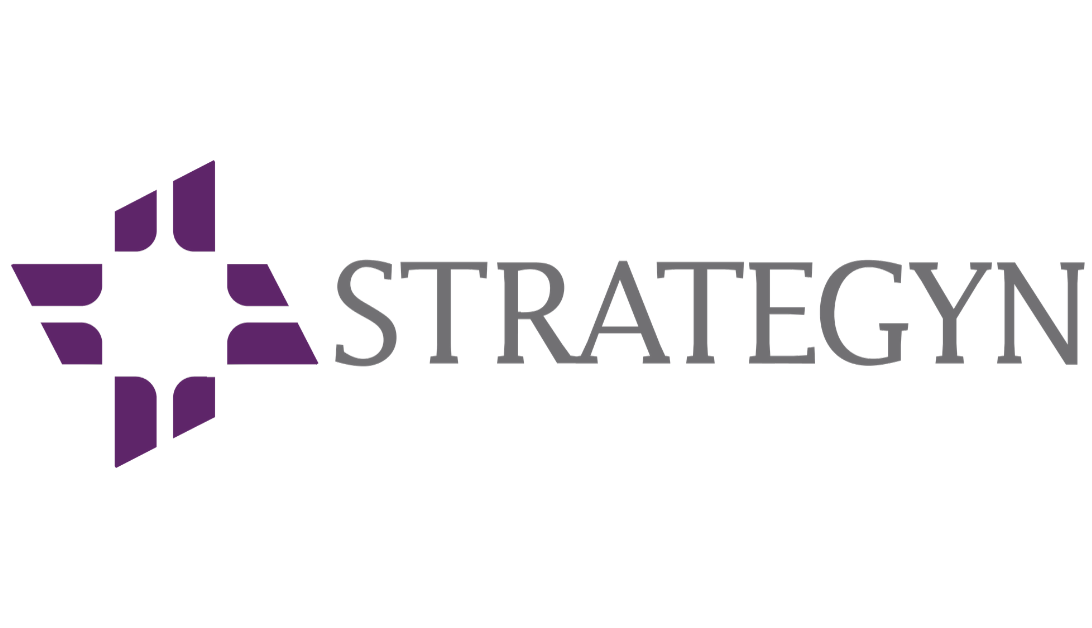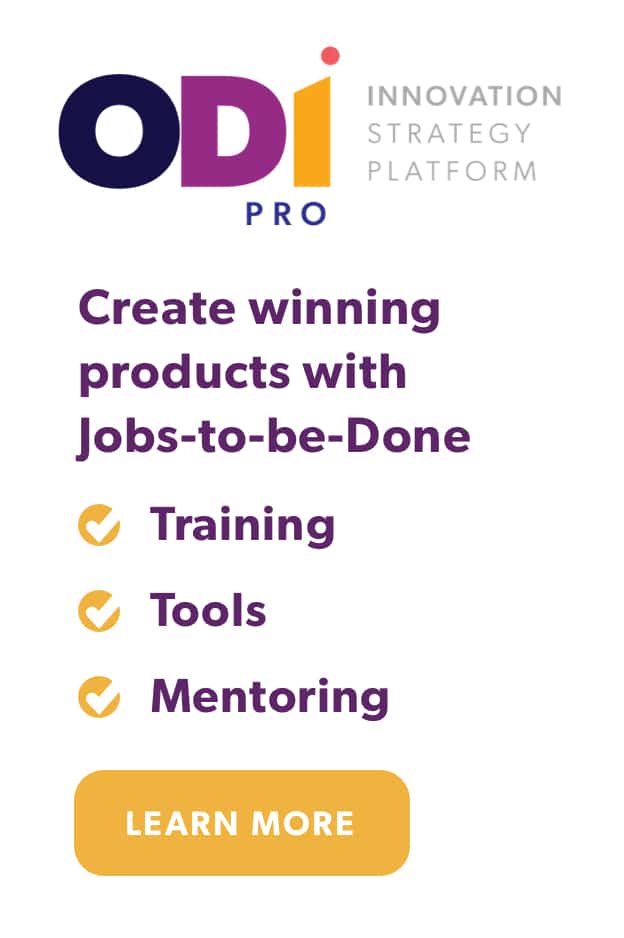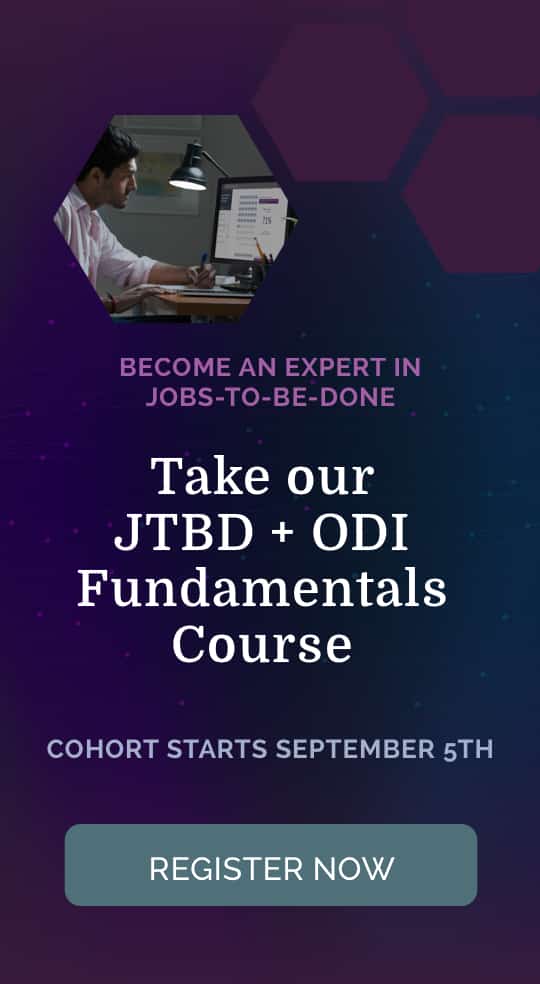Defining the customer’s job-to-be-done correctly is fundamental to a company’s success. Don’t let these two common mistakes derail your innovation efforts.
“People don’t want a quarter-inch drill. They want a quarter-inch hole.”
This quote, which was made popular by Theodore Levitt, forms the foundation for Jobs-to-be-Done Theory: the notion that people buy products (like drills) to get a “job” done (e.g., create a quarter-inch hole). Sounds simple enough — companies are in business to create products and services that help customers get a job done.
Jobs-to-be-Done Theory goes on to say that a deep understanding of the job the customer is trying to get done will reveal unique insights that can make innovation more predictable, which is proven to be true (see Core JTBD Tenets). But exactly what customer and what job is it that a company should study?
In Levitt’s statement he implies that the job to study is the job of creating a quarter-inch hole. But what if, as a researcher, you notice that people are creating the quarter-inch hole because they are trying to hang a framed picture on the wall? And they are hanging the picture on the wall because they want to create an attractive workspace? And they want to create an attractive workspace because they want to be successful in their profession? People may be trying to get all these jobs done, so which job should be the unit of analysis? What is the correct level of abstraction?
As a researcher, you may also decide to talk with buyers and users of drills. In doing so you may discover very different sets of customer needs. Then the question becomes, “Which customer should be the focal point for data collection and innovation?”
You can see from Levitt’s example that defining the customer and the customer’s job-to-be-done can quickly take you down a rabbit hole if you fail to consider two very important factors:
1. The customer’s job-to-be-done that is pertinent to a company is dependent on that company’s business objectives. While a customer may be trying to get a variety of jobs done, a company may have a mission, the capabilities or the desire to address only one of them. This is a market selection decision.
2. The user of a product is the only person capable of providing the inputs needed for product innovation. Buyers, in many cases, are not users and while they can help you understand the buyer’s journey, they are not qualified to speak about the user’s core functional job.
These factors form the foundation for advice to avoid the two most common mistakes companies make when starting to apply Jobs-to-be-Done thinking in their organization.
Don’t ignore the company’s business objectives
Let’s say, for example, that you are a drill manufacturer, and you are trying to improve your existing products or replace (disrupt) them with new products that create holes. In this case, studying the job of “hanging a picture on the wall” or “creating an attractive work space” isn’t going to help you. Given that your company makes drills and wants to continue to make drills or competing products, you would need to study the job of “creating a hole.” Consequently, you would interview users of competing products that are being used to create a hole, e.g., a hand drill, electric drill, a hole punch, a hammer/nail, etc.
With a deep understanding of all the metrics customers are using to measure success when creating a hole (their desired outcomes) and new insight into which outcomes are under/overserved, you could then:
- Conceptualize new features that would improve your existing products, and:
- Conceptualize all-together new products that could disrupt or complement your existing offerings.
On the other hand, if you are a frame/hardware manufacturer, and you are trying to improve your existing products or replace (disrupt) them with new picture hanging products, studying the job of “being successful in my profession” or “creating a quarter inch hole” isn’t going to help you. As a frame/hardware manufacturer, you would need to study the job of “hanging a picture on a wall.” Consequently, you would interview users of all competing products that are being used to hang a picture on a wall, e.g., wires, anchoring systems, etc.
With a deep understanding of all the metrics customers are using to measure success when hanging a picture on a wall and insight into which outcomes are under/overserved, you could then:
Conceptualize new features that would improve your existing products, and:
Conceptualize all-together new products that could disrupt or complement your existing offerings — and potentially eliminate the need to drill a hole.
It is important to note that even if the frame/hardware manufacturer created a new frame that eliminated the need for drilling a hole in order to hang a picture, the market for drills will not disappear. People will continue to buy drills to make holes in many other contexts — and the drill maker will still need to study the job of creating a hole.
The beauty of the Outcome-Driven Innovation process is that it can be used to study any job at any level of abstraction — and optimized to address the business objectives of the company that is seeking to grow through innovation. Keep in mind that a job-to-be-done can be an objective, a goal or a task, a problem to be solved, something to be avoided, or anything else that groups of people are trying to accomplish.
Don’t confuse the buyer’s journey with the user’s job-to-be-done
A second common mistake that we see people make when attempting to apply Jobs-to-be-Done thinking is that they confuse the buyer’s job (and outcomes) with the user’s job (and outcomes).
The reason Jobs Theory is so powerful is that it enables a company to deeply understand the core functional job the customer is trying to get done when using the product. Studying the job-to-be-done reveals the metrics that people use to measure success when getting the job done and opportunities to get the job done better/more cheaply.
But here is the problem — in many cases, especially in B2B applications, the buyer of a product has little or no experience using the product to get the functional job done. But because the company has a relationship with the buyer, and not the user, researchers end up talking to buyers about their buying job (the buyer’s journey) and fail to obtain the insights required to understand the job that the user is trying to get done (the core functional job).
While studying the buyer’s job (journey) can lead to insights that help innovate the purchase process, the inputs collected about the buyer’s journey will not help to innovate the product itself — and thinking they will is a common mistake.
Avoiding these two common mistakes will go a long way in helping you get your Jobs-to-be-Done efforts off on the right foot.




